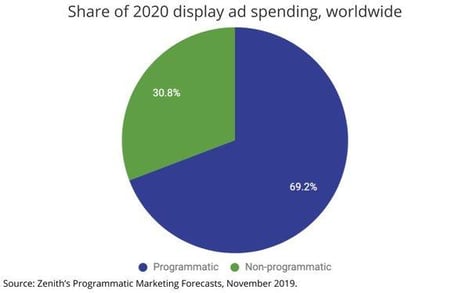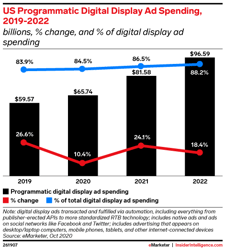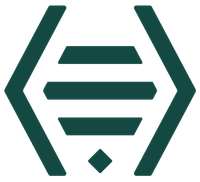What Programmatic Meant in 2020 and What It Means in 2021
Programmatic by definition automates the process of advertising, but what it means to the industry has changed dramatically in recent years. It’s still a relatively new technology, but it’s evolved rapidly in the decade since its debut. From the early days of the 2010s, when brands and agencies were skeptical of its capabilities and of its safety for highly visible brands, to today, when brands are investing more and more and more of their budgets into programmatic.
However, at no point in time has programmatic seen a bigger upturn than from 2019 through today. Between an increase in digital budgets vs. traditional media (despite a downturn in overall ad spend in 2020 in some markets) and a new maturity in our understanding and usage of data, programmatic has powered through its adolescence in the past year. While changes in privacy laws and practices – from GDPR to the cookiepocalypse – have meant dramatic shifts in how we target, what we’re seeing is the beginning of the true heyday for automated, data-driven advertising.
Pandemic drives unexpected programmatic growth
In 2019, programmatic increased as a percentage of digital ad spend, but that growth had slowed. MediaPost reported in November of that year that programmatic ad spend would only increase four percent, from 65 to 69 percent of all digital media globally in the year ahead, jumping to over 72 percent in 2021.

Of course, no one saw a global pandemic looming on the horizon, and for digital advertising (like everything else), that changed everything. With everyone at home, screen time increased astronomically – and with it, the demand for digital ads. eMarketer notes that while it made cuts to its pre-pandemic forecast, US programmatic digital display ad spending actually grew more than 10 percent in 2020 – well beyond the four percent predicted, and will climb to 24.1 percent growth in 2021. Globally, spend jumped from $106 billion in 2019 to $127 billion in 2020 – and is expected to climb another $27 billion this year. What that means, essentially, is that marketers are seeing the programmatic opportunity that has resulted from global stay-at-home orders, or at least, reacting intelligently to the change in their audience’s behavior.


More digital than analog as stay-at-home orders persist
For most consumers around the world, the pandemic means more time at home. That has resulted in a surge in digital media consumption since March 2020, as more people worked at home, worked out at home, joined classrooms from home, streamed TV shows, and more. Those behaviors continue as people around the world continue to shelter in place.
Those changes mean new and different opportunities for marketers. B2B marketing professionals who previously allocated the lion’s share of their budget to trade shows and conferences now have more money to invest in digital. Brand marketers who invested in live events, OOH, and even POP displays are now looking at purely digital alternatives as well. In 2021, if you want your messages to be seen by consumers, screens are the best investment.
Fortunately, the programmatic opportunity makes it easier to reach audiences of all kinds in a broad range of environments. Reaching B2B buyers in business publications is no more or less difficult than reaching Millennials in gaming apps or Boomers via OTT. As marketers review the new habits of their target audiences, they can rely on programmatic to help them reach and engage, wherever those audiences are these days.
Beyond the pandemic: programmatic in 2021
As vaccinations achieve critical mass and “normal” life can resume, programmatic will continue to play a huge role in digital marketing. Many businesses will continue to offer employees the opportunity for a flexible work schedule; in fact, just one in 10 companies expect to see their full staff return to the office. More white-collar workers will continue to log on from home and will therefore be less likely to interact with digital OOH, geofenced campaigns targeting their office complex, or other common tactics used to reach professionals.
Marketers will have to find other creative targeting strategies to engage both at-home workers and those who are ambivalent about returning to malls, restaurants, and other crowded environments. And they’ll have to do it without the use of cookies.
As we’ve mentioned in previous articles, the demise of the cookie will impact how marketers target their audiences, and that will make for an interesting plot twist in 2021. In fact, this challenge will likely define programmatic’s future, as the path forward isn’t yet clear. While many believe first-party data will guide the way, there are many other possible paths.
Whatever the future beyond coronavirus holds for digital advertising, programmatic will undoubtedly play a huge role. Programmatic by definition is the automation of digital advertising, and those automated systems continue to get smarter even as it expands across channels. As digital spend increases, programmatic will make even six-and-seven figure ad spends manageable for marketing teams. And as more companies rely on programmatic to broaden their reach, Beeswax will be here to support their efforts and help them get the most out of their digital spend.



